The Gothic cathedral architecture originated in France in the early 12th century during the heydays of the Knights Templar. The Knights Templar officially called the ‘Poor Fellow-Soldiers of Christ and of the Temple of Solomon’ formed a knight’s order of priests who protected the pilgrimage routes to Jerusalem.
The order was founded in 1118 by Hugo van Payens who managed to team up nine brave knight-priests. This group of nine knights became to be one of the richest and most powerful groups in history. With their huge wealth, collected from financing the crusades, they were able to build the Gothic cathedrals in Europe. The cathedrals with their twin towers facing the West resemble the Temple of Salomo with its two pillars Jachin and Boaz that stood in front of the temple. This explains why in many cases a statue of Salomon is placed at the West portal of the French cathedrals in between the twin towers.
Many books have been written about the mysteries of the French Gothic cathedrals and its sacred geometry used in the architecture. A well known book is ‘Le Mystère des Cathédrales’ written in 1929 by Fulcanelli (1839 - 1953), the mysterious French alchemist who was one of the first to write about the mysteries surrounding the French cathedrals. According to Fulcanelli a cathedral is an alchemical book written in stone.
The End of Time
A visitor entering the cathedral is immediately confronted with ‘The Last Judgment’ that is displayed at the tympanum (mural) above the entrance. In the tympanum Jesus is displayed surrounded by the four beasts of the Apocalypse. These four beasts are mentioned in John’s Revelations and have been equated with the four apostles of the four canonical books of the bible, Matthew, Mark, Luke and John. The four beasts of the Apocalypse have an astrological significance. The beast with the human face correlates with Aquarius (Matthew), the lion with Leo (Mark), the ox with Taurus (Luke) and the eagle with Aquila (John). The zodiac sign Aquila is often replaced by the zodiac sign Scorpio in ancient zodiacs.
In Christian art expressions Christ is often portrayed inside a Vesica Pisces along with these four zodiac signs and surrounding Christ’s head a halo is displayed resembling the Sun. The cross in the halo in reality could therefore be a reference to these four signs of the Apocalypse, since Taurus, Aquarius, Scorpio and Leo together form a perfect cross in the zodiac.
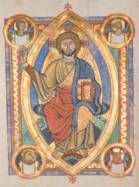 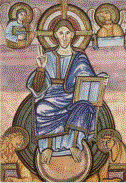
Jesus inside the Vesica Pisces (Codex Bruchsal) with the four signs of the Apocalypse, upper left (Aquarius), upper right (Scorpio alias the eagle), bottom right (Taurus), bottom left (Leo)
In prior articles I’ve argued that the Four Evangelists of the New Testament, just like the four beasts of the Apocalypse represent the signs of the Galactic Cross.
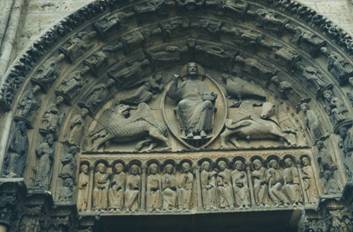
‘Last Judgment’ Chartres West Royal Portal
Chartes Notre Dame Cathedral
One of the oldest Gothic cathedrals in France is Chartres cathedral. This cathedral is aligned to the summer solstice. On the summer solstice the Sun shines through the window of ‘Saint Apollinaire’ with a depiction of the Roman sun god Apollo and its rays fall straight on an iron nail in the floor of the cathedral.
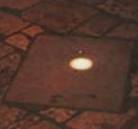
Summer solstice Sun cathedral of Chartres
 Inside the cathedral one can find a zodiac which is rather peculiar since in Christian tradition practicing astrology is regarded as an act of paganism. This zodiac however seems to be telling something extraordinary. The first thing that attracts one’s attention is the cross in this zodiac that connects the four signs Taurus, Aquarius, Scorpio and Leo. Similar to the ‘Last Judgment’ this zodiac cross seems to denote the importance of these four signs and presumably must be associated with ‘The End Times’ as well.
The reason might be that these four signs rise heliacal (before the sun) during a Great Celestial Conjunction at the solstices and/or equinoxes. They are thus the symbols of the true Galactic Cross determined by the places in the zodiac where the ecliptic and the Milky Way cross. The importance of the Great Celestial Conjunction of 2012 is that it marks the event after 6480 years when the equinox and solstice axis of the zodiac cross merge again with the Galactic Cross. This is the time the 26.000 year precession cycle will be concluded and a new cycle will commence. This is what in John’s Revelations has been called ‘The End Times’.
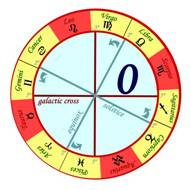 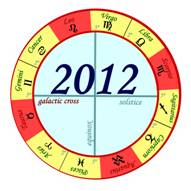 Equinox-solstice cross aligns and merges with the Galactic Cross around 2012
The next thing that attracts one’s attention about the zodiac in Chartres cathedral are the two semicircles in the zodiac that intersect to form a Vesica Pisces. A Vesica Pisces is an important ancient symbol later adopted by Christians to represent Christ. When vertically depicted, the Vesica Pisces represents the vagina of the goddess mother and as such was associated with fertility and birth. Christ is often depicted inside the Vesica Pisces in a vertical position like in the ‘Last Judgment’ of the tympanum above the West Royal Portal of Chartres cathedral. This symbolism therefore refers to the rebirth or Second Coming of Christ at the ‘End of Time’.
When the Vesica Pisces in the zodiac of Chartres is carefully inspected, something interesting is discovered. The intersection of the Vesica Pisces aligns with the Pisces-Virgo axis in the zodiac. This is a hint that the Vesica Pisces should be associated with both the signs Pisces and Virgo. The esoteric astrological significance is that Pisces stands for Christ (the fisherman) while Virgo stands for Mary (the virgin mother). It was the virgin mother Mary (Virgo) that gave birth (Vesica Pisces) to Christ (Pisces).
Great Celestial Conjunction
There is only one very important astronomical rebirth taking place in Pisces around era-2012 and that’s the rebirth of the Sun in the precession cycle on the Galactic Cross. This moment denotes the start of a new precession cycle. Could it be that the Chartres zodiac was meant to denote this astronomical event?
In the years of the Great Celestial Conjunction (1978-2017) the 5° Pisces - 5° Virgo axis of the Galactic Cross will align with the equinoxes, while the 5° Gemini - 5° Sagittarius axis (sidereal zodiac) of the Galactic Cross will align with the solstices. The Galactic Cross therefore occurs in the Chartres zodiac and is defined by the Vesica Pisces!
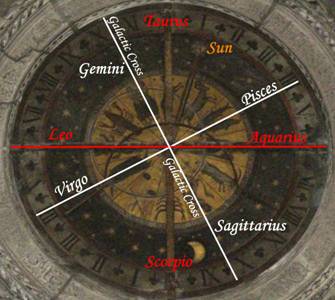
Chartres Zodiac. The axis of the Vesica Pisces coincides with the axis of the Galactic Cross during the current Great Celestial Conjunction around 2012!
The cross Taurus, Aquarius, Scorpio Leo cross corresponds in addition with the cardinal directions. If this cross is interpreted this way interesting new insights come to light. The Sun depicted in the upper right corner of the zodiac is now situated in the northeast at the place where the Sun rises during the summer solstice.
Notice that a line is drawn from the Sun to the center of the zodiac. This line connects the Sun with the birthplace of the Sun, meaning inside the Vesica Pisces (the female birth canal) and at the centre of the Galactic Cross! The Vesica Pisces therefore suggests the rebirth of the Sun during the summer solstice in Pisces during the Great Celestial Conjunction of 2012.
The symbolism used here suggests that the Christian doctrine of the ‘End Times’ is not about the rebirth of Christ at all, but actually about the rebirth of the Sun! This is most likely why Jesus is placed inside the vertical Vesica Pisces surrounded by the four beats of the End Times in the ‘Last Judgment’ in the first place!
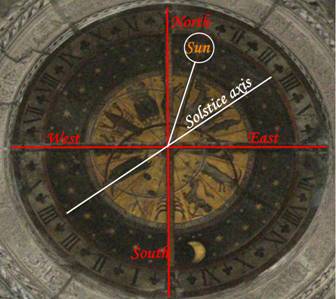
The zodiac corresponds with the summer solstice. The summer solstice Sun is depicted in the northeast (summer solstice sunrise).
Black Madonna
Are there more reasons to suspect that the biblical ‘End Times’ in reality is about the rebirth of the Sun? The fact is that there is actually a very convincing clue left in Chartres cathedral dealing again with the very same symbol, the Vesica Pisces.
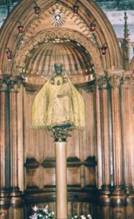 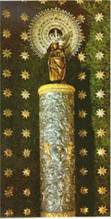
Left: Black Madonna Chartres. Right: de ‘Our dear Lady of the Pillar’ amidst eight pointed crosses
Chartres cathedral is well known for its Black Madonna veneration. The Black Madonna however has nothing to do with Mary. In reality she represents the pagan Egyptian mother goddess Isis. In her arms she’s therefore not holding Jesus but the immaculate conceived son, the sun god Horus! Isis like Mary was a virgin who gave birth to a son on the 25th of December. This is exactly four days after the winter solstice, the moment of the rebirth of the Sun in the annual cycle after the Sun has ‘died’ on the cross of the zodiac at the winter solstice day.
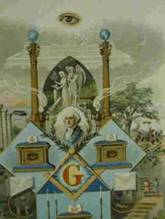 Tracing board with the Immaculate Conception of Mary. Mary is standing in between the two pillars of the temple of Solomon inside a Vesica Pisces. At the top the All Seeing Eye (representing the eye of Horus) is depicted. The tracing board symbolizes the birth of the solar deity Horus at the Milky Way.
In the freemasons Tracing Board (see picture above) Mary’s Immaculate Conception is depicted. She’s placed inside a Vesica Pisces in between the two pillars of the temple of Solomon with the All Seeing Eye of Horus watching over her. This maconic Tracing Board reveals that the birth of Christ in reality is mimicking the birth of Horus, the Egyptian Sun God.
Notice that the ‘virgin Mary’ in Chartres is placed on a pillar in a Vesica Pisces shaped cavity. The origin of this custom to place the virgin mother on a pillar in Christian traditions stems from the legend of ‘Our Lady on the Pillar’. The legend relates to the appearance of the virgin mother to the apostle James in the early days of Christianity on top of a column or pillar carried by angles.
In Masonic traditions this pillar however represents the Milky Way. The symbolism of placing the Black Madonna with Jesus on a pillar must therefore be equated with the Sun (Horus) on the Milky Way. The Sun will be at the Milky Way at the ‘End of Time’ during the summer and winter solstice of 2012.
Zodiac window
In the ambulatory a stained glass window contains the twelve signs of the zodiac. On top in a four leaf clover, hence representing a form of cross, Christ is depicted in between the Greek letters alpha and omega. In Christianity Christ’s birth is represented by the letter alpha and his Second Coming at the ‘End of Time’ with the letter omega. The letters alpha and omega in this zodiac are therefore most likely representing the beginning and end of the precession cycle. The Great Celestial Conjunction of 2012 will be the alpha and omega point in the precession cycle, the moment of a cycle ending and new cycle starting.
The four signs (Leo, Taurus, Aquarius, Scorpio) that are associated with the Galactic Cross are depicted similar to Christ in a four leafed clover. All of the other ‘regular’ signs of the zodiac are depicted in ordinary circles. There is however one little error introduced in this zodiac. Taurus of the Galactic Cross (Aquarius, Scorpio, Leo and Taurus) has been deliberately replaced by the sign Gemini. The summer solstice of June 21st takes place during the last day of Gemini (May 22 – June 21). By exchanging Taurus with Gemini, whereas Gemini must be associated with the summer solstice Sun, the summer solstice Sun is placed on the Galactic Cross! The summer solstice Sun at June 21st 2012 will reside in Gemini at the Galactic Cross where the ecliptic and the Milky Way cross!
So this zodiac window in Chartres is clearly a reference to the summer solstice Galactic Alignment of 2012, the Great Celestial Conjunction of 2012.
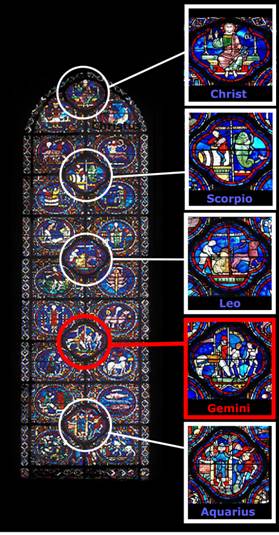    Chartres Cathedral is the centre of a pilgrimage tradition with its focus-point the Black Madonna, also known as the Virgin of the Crypt. There appears to have been an altar to the Virgin going back as far as the 6th Century in the then church at Chartres. The church was known to be dedicated to the Virgin as early as the 8th Century and received a relic called the 'Veil of the Virgin'. The crypt became a centre of healing, in a similar way to Lourdes today. However, the ancient statue of 'Our Lady of the Crypt' was burnt in front of the church in 1793 during the French Revolution, which itself seems an extreme event for a holy Roman relic. Chartres Cathedral is the centre of a pilgrimage tradition with its focus-point the Black Madonna, also known as the Virgin of the Crypt. There appears to have been an altar to the Virgin going back as far as the 6th Century in the then church at Chartres. The church was known to be dedicated to the Virgin as early as the 8th Century and received a relic called the 'Veil of the Virgin'. The crypt became a centre of healing, in a similar way to Lourdes today. However, the ancient statue of 'Our Lady of the Crypt' was burnt in front of the church in 1793 during the French Revolution, which itself seems an extreme event for a holy Roman relic. Taurus is deliberately replaced by Gemini introducing an error in the zodiac sequence.  The magnificent Cathedral at Chartres, France is a Gothic masterpiece adorned with a host of unusual symbolism. Its origins have been connected to the Knights Templar, the powerful Order of mediaeval Knights who bankrolled much of Europe before succumbing to the charge of Heresy and a subsequent witch-hunt. Its overpowering stone structure stands as an eternal Testament: Its focus is the hidden heretical meaning to be found within orthodox teachings. The magnificent Cathedral at Chartres, France is a Gothic masterpiece adorned with a host of unusual symbolism. Its origins have been connected to the Knights Templar, the powerful Order of mediaeval Knights who bankrolled much of Europe before succumbing to the charge of Heresy and a subsequent witch-hunt. Its overpowering stone structure stands as an eternal Testament: Its focus is the hidden heretical meaning to be found within orthodox teachings. When I visited Chartres this year I hoped to discover evidence of the Dark Sun, the binary companion Nibiru. I thought that it might require some hunting around to find clues and hints among the many artefacts in the Cathedral. What I was not expecting was clear and self-evident symbolism of Nibiru to be openly portrayed in the heart of the Cathedral. What had aroused such animosity among the revolutionaries to make such a public show of burning this artefact? A more modern version is now found in the famous crypt of the Cathedral. The Cathedral's guide-book has this to say about the object of the pilgrimages: "The crypt is the origin and heart of the pilgrimage. For many centuries Our Lady of Chartres has accepted the homage of her votaries. Our Lady of the "Belle Verrière" was once an object of veneration, and particularly invoked by women before childbirth, and formerly, there was the gilt statue on the main altar, where people knelt in prayer as today before Our Lady of the Pillar." [my emphasis]  Chartres is full of female imagery connected with the Virgin. This concentration on the feminine has raised the idea among many that the iconography of Chartres Cathedral represents ancient pagan Goddess worship wrapped up in the orthodox Christian tradition. Such claims are helped along by the bizarre inclusion of Zodiacal and Astrological imagery in the Cathedral. Chartres is full of female imagery connected with the Virgin. This concentration on the feminine has raised the idea among many that the iconography of Chartres Cathedral represents ancient pagan Goddess worship wrapped up in the orthodox Christian tradition. Such claims are helped along by the bizarre inclusion of Zodiacal and Astrological imagery in the Cathedral. The zodiac seen here is displayed in the 13th Century 'Ambulatory'. Damon Elkins and Michael Lawrence Morton have expressed great interest in the bisection of the red semi-circle and the off-centre white circle in the zodiac. Is this an esoteric depiction of the perihelion orbital path of Nibiru? If so, what exact conclusions can we draw from the image about the sky-location of this hidden Dark Star? More on this later... These images owe more to Paganism than Catholicism. The suggestion, then, is that the veneration of the Virgin is tantamount to ancient Goddess Worship of figures such as Diana, Cybele and Isis, and the like. If the Virgin represents an Isis-like goddess, then Christ is Horus, her all-conquering child of ancient Egyptian mythology. Having no place in Christian teachings, such suggestions are deeply heretical. Yet they strike a chord among many, and it is indeed difficult to explain what the strange symbolism of Chartres is about otherwise. Particularly when we consider the symbolism of the Lady of the Pillar. 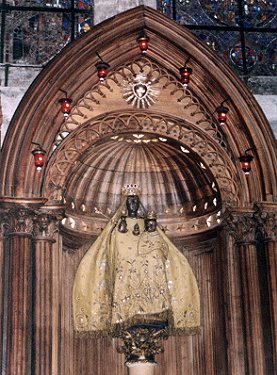 Our Lady of the Pillar is a classic example of the Black Virgin and was carved for a ground-level shrine in the Cathedral that would draw the worshippers away from the busy main altar in the crypt. Black Virgin statues are the subject of passionate followings by local worshippers, but are generally frowned upon by the orthodoxy within the Catholic Church. Our Lady of the Pillar is a classic example of the Black Virgin and was carved for a ground-level shrine in the Cathedral that would draw the worshippers away from the busy main altar in the crypt. Black Virgin statues are the subject of passionate followings by local worshippers, but are generally frowned upon by the orthodoxy within the Catholic Church.Their origin is somewhat opaque, possibly because the Church prefers to keep a low profile about them, and certainly does not study their original source. The pagan connection is a fascinating possibility, and is further supported by the astronomical imagery employed, as described by Picknett and Prince: "It is acknowledged that the early Christians appropriated much of Isis' iconography for the Virgin Mary. For example, she was given several of Isis' titles - such as 'Star of the Sea' and 'Queen of Heaven'. And, traditionally, Isis was shown standing on a crescent moon, or with stars in her hair or around her head: so is Mary the Virgin".  Certainly, one cannot deny the stellar symbolism literally surrounding Our Lady of the Pillar at Chartres. A further hint at the Pagan meaning is the inclusion of a scene of Worship of Diana in the stain glass above the shrine. I would like to draw your attention to the highly remarkable symbols above the Black Virgin depicted in my photographs. She is elevated upon a pillar, with Christ/Horus, within a hemisphere of stars, representative of the vault of the night sky. Above the sphere of the stars is a curious white, radiant symbol. It is contained within an arch that has seven red lights resplendent about it. Certainly, one cannot deny the stellar symbolism literally surrounding Our Lady of the Pillar at Chartres. A further hint at the Pagan meaning is the inclusion of a scene of Worship of Diana in the stain glass above the shrine. I would like to draw your attention to the highly remarkable symbols above the Black Virgin depicted in my photographs. She is elevated upon a pillar, with Christ/Horus, within a hemisphere of stars, representative of the vault of the night sky. Above the sphere of the stars is a curious white, radiant symbol. It is contained within an arch that has seven red lights resplendent about it. This imagery is inexplicable. At least to anyone unfamiliar with Dark Star research. These are the symbols of the Dark Companion of the Sun; the mythical Nibiru, representative of a distant encircling massive planet categorised as a sub-brown dwarf. The radiant emblem central to the motif is the Dark Star Nibiru itself, held aloft beyond the Heavens, indicating its hidden nature beyond the planetary spheres. The seven red lights are its attendant moons. The overall impression is that of the other Dark Star icon; the 'Winged Disc'.  This visitor to Chartres Cathedral shows her devotion to the Black Madonna. The statue has a veil over it on this occasion, being Good Friday. Other statues were similarly adorned. I have argued that many of the ancient religions, and some of the more modern esoteric traditions, hold Nibiru to be their hidden Truth. This Truth is heretical to Monotheistic faith, and is represented by an underground tradition of symbolism that to some extent has been clouded by the mists of time: Nibiru, I argue, last came past the Solar System 2000 years ago and is currently about as distant as it can be. But its quiet intrusion into the skies 2000 years ago created a revolution in religion. The child Horus was born again to the World in the form of Christ. It was an astrological arrival of a dead star whose cyclical return was so buried in ancient history that it had been almost entirely forgotten about. Except for some vague references to the return of a Messiah. This motif on the outside of the Cathedral building shows the Star within a seven-pointed halo; more Dark Star symbolism:   What has this to do with the Virgin? The 'Son of the Sun' was born into the Heavens near to a specific star: Sirius. The bright star Sirius is a stellar representative of the Goddess Isis, and is thus representative of the Virgin Mary, by ancient association between the two cults of these allied female deities. What has this to do with the Virgin? The 'Son of the Sun' was born into the Heavens near to a specific star: Sirius. The bright star Sirius is a stellar representative of the Goddess Isis, and is thus representative of the Virgin Mary, by ancient association between the two cults of these allied female deities. This is the true meaning of Our Lady of the Pillar in Chartres Cathedral: that Christ was born when the dead failed star Nibiru dropped briefly into the Heavenly Sphere near Sirius, or Isis. It appeared as a purple/red Winged Disc with seven accompanying stars, 'born' of Sirius. So the star-covered shrine represents the perihelion transit of the celestial Crown and Seven Stars of Nibiru through the Duat, the celestial home of Isis, the mother goddess. Its emergence into the consciousness of Mankind is indeed a rightful focus of continued veneration, as it was in ancient times. The above picture is taken from the Chartres Cathedral guide. To the left can be seen the Zodiac pictured previously. It is a remarkable artifact to be found in a Christian Cathedral, and yet is not mentioned at all in the guide! I took my photographs when I was in a bit of a hurry; owing to the fact that our car was parked for just one hour in the town (one hour to take in the complex glories of Chartres: A heresy in itself!) So I can't recall whether the zodiac had any moving parts, but it seemed to be a static installation. Let's take a closer look.  Michael Lawrence Morton and Damon Elkins noticed from the picture on this page that there are two intersecting paths on the zodiac: a white circle set off-centre from the central point (which must be the Sun), and a raised, red bar extending out to a fiery disc. The later would appear to be the Sun at the first instance, but a moment's thought will lead one to realise that the red path is not that of the Sun's. The Sun must preside in the centre of the motif; the locus of the zodiac. So the fiery object to the top right is therefore either the Dark Star, or the Sun connected to its rightful place in the centre of the Zodiac. Michael Lawrence Morton and Damon Elkins noticed from the picture on this page that there are two intersecting paths on the zodiac: a white circle set off-centre from the central point (which must be the Sun), and a raised, red bar extending out to a fiery disc. The later would appear to be the Sun at the first instance, but a moment's thought will lead one to realise that the red path is not that of the Sun's. The Sun must preside in the centre of the motif; the locus of the zodiac. So the fiery object to the top right is therefore either the Dark Star, or the Sun connected to its rightful place in the centre of the Zodiac.If it is the Dark Star, then the red path intersects the ecliptic at Pisces and Virgo. The path is then 'within' the ecliptic through Aries, Taurus, Gemini, Cancer and Leo. These constellations are the five central constellations of the perihelion transit of Nibiru, as I have argued in my book 'Winged Disc' (2001), except that the path is not along the ecliptic exactly, achieving perihelion near Sirius and Orion. 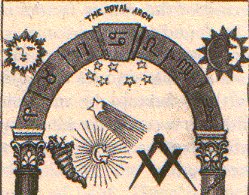 This would then explain why the red path arches over the ecliptic, and why the ecliptic is off-centre from the Sun's central position; the Zodiac is describing the passage of an object that travels 'off-road' from that of the other planets. This would then explain why the red path arches over the ecliptic, and why the ecliptic is off-centre from the Sun's central position; the Zodiac is describing the passage of an object that travels 'off-road' from that of the other planets.This set of perihelion constellations is repeated in the Royal Arch of the Freemasons, known to some as the 4th degree of the Craft; an extension of the Master Mason 3rd degree. In this context a bright comet is seen closely associated with the Masonic symbol 'G', the Great Architect of the Universe. This high deity is revealed in the degree as JAH-BUL-ON, a composite of Jahweh, Baal and Osiris. That this high deity is associated in the Royal Arch iconography with a comet and seven stars is absolutely incredible; these are archetypal Dark Star symbols. I believe that this degree initiates the Master Mason into the realisation that Christian thinking alone is not sufficient to grasp the deep mysteries. Instead, a Gnostic flavour is introduced in the higher degrees of Freemasonry, allowing the celestial connections to the mysteries to be explored. And that teaching is featured on the walls of the Ambulatory in Chartres Cathedral, even though no mention of this is made in the Guidebook. But it is there, none the less; an esoteric teaching placed prominently before the masses meandering through the Cathedral. It tells of a comet and seven stars returning to the Duat; a secret that only one fifth of Master Masons ever get to find out about, and that's if they have the slightest clue what they are learning about in their ritual!  © Andy Lloyd 25th July, 26th September 2004 and updated 26th April 2006  what does A MIDI POMMES BLEUES mean?  Refers to Saint Sulpice. Both the equinoxes spots appear in front of La Poulpe - The Octopus. The Ancient Greek symbol for the constellation of Cancer is an Octopus. References A. Lloyd "Winged Disc: The Dark Star Theory" Self-published 2001 Z. Sitchin "The Twelfth Planet" Avon 1976 É. Houvet 'Chartres - Guide to the Cathedral' Houvet D. Ovason 'The Zelator: The Secret Journals of Mark Hedsel' Arrow, 1999 L. Picknett and C. Prince 'The Templar Revelation' Corgi 1998 Fulcanelli, 'The Mystery of Cathedrals' Pauvert, Paris, 1925 S. Knight "The Brotherhood" Granada 1983 Correspondence with Damon Elkins and Michael Lawrence Morton, 22nd September 2004 A better image of the Chartres Zodiac with thanks to Shaun Bourke LOS OFICIOS DE LA EDAD MEDIA A TRAVÉS DE LAS VIDRIERAS DE LA CATEDRAL DE CHARTRES
M.ª
Teresa Jiménez Priego
Las
catedrales de la Edad Media son como libros de imágenes; imágenes
de piedra e imágenes de cristal destinadas a la edificación
de los hombres.
Estas
imágenes reproducen escenas de la vida de Cristo, de la Virgen,
de los Santos, de los ángeles, otras simbologías y acciones
realizadas por los hombres. Así, en la catedral de Chartres,
podemos contemplar desde la Historia de Carlomagno, la vida de San Esteban,
escenas evangélicas y de otros santos, el Árbol de Jesé,
junto con la plasmación de los distintos oficios que el hombre
de estos siglos XII y XIII realiza.
De
esta iconografía del trabajo es de la que nos vamos a ocupar.
Es necesario darnos cuenta de la importancia de Chartres en esta época
como lugar de peregrinación, como uno de los centros intelectuales
más importantes de la cristiandad, así como de una de
las más célebres escuelas de medicina, de juristas y sobre
todo de filósofos y teólogos. Esto explica que los obispos
de Chartres fueran hombres tan importantes, capaces de atraer hacia
la obra de su catedral la afluencia de innumerables trabajadores voluntarios
y aún más de donantes que financiaron la construcción.
Si
el interior es transfigurado siempre por las vidrieras, podemos imaginar
hasta qué grado lo sería el de esta catedral cuyo conjunto
de vidrieras constituyó uno de los más bellos de todas
las épocas.
Sabemos
que correspondieron a los siglos XII y XIII. Al primero pertenecen las
de las tres ventanas de la fachada principal y las de la "Belle
Verriére" (la primera del deambulatorio a la derecha), caracterizadas
por el azul límpido, el famoso azul de Chartres. Los dos rosetones
y el conjunto de las otras vidrieras (salvo las de la capilla de Vendóme,
del siglo XV) son del siglo XIII y recuerdan las de Bourges y la rosa
W de Notre-Dame de París. Es difícil seguir la evolución
del estilo en estas vidrieras realizadas en un tiempo tan corto (entre
1210 y 1236), así como los diferentes talleres a los que pueden
pertenecer.
Zapateros, tejedores, panaderos, cambistas, taberneros,
vinateros, herreros, abaceros, farmacéuticos, peleteros, curtidores
y remendones, todos prosperaban con el tráfico que la reconstrucción
de la catedral llevó a Chartres. Todos querían estar representados
e inmortalizarse en ella. Esto les condujo a ofrecer una vidriera en
la que apareciese su profesión.
El precedente se esta acción fue la realizada
por los nobles quienes donaron vidrieras a las catedrales e instauraron
la costumbre de representar sus propias imágenes en otras menores
situadas debajo de las grandes.
Mas observemos que, si los anteriores artesanos citados,
necesitaban de esta representación vitral para aparecer directamente
en la catedral -dado que su trabajo no incidía en ellas sino
de rechazo- curiosamente hasta los albañiles, escultores, carpinteros,
herreros y otros que trabajaban directamente en la construcción
también hicieron colectas y pagaron una o varias vidrieras. Incluso
el humilde gremio de los aguadores, que parecen haberse formado exclusivamente
con el propósito de costear una vidriera, donó una a una
capilla. Resultan conmovedores estos aguadores portadores de cántaros
que se ven representados debajo de la gran vidriera donada por ellos
y dedicada a santa María Magdalena (1).
Muchas otras vidrieras parecen igualmente apropiadas.
El primer misionero, San Pablo, vuelve a vivir en el vidrio para verlo
todo, mientras debajo, los cesteros confeccionan abiertamente sus cestos.
Ezequiel, David y un ángel miran hacia abajo desde el piso iluminado;
debajo de ellos los carniceros cortan la carne (2). Mientras la Virgen
recibe a los Magos, los panaderos extienden sus panes (3). Los mismos
panaderos preparan algunas barras bajo la figura de Moisés, el
cual estuvo durante cuarenta años sin probar, y ni siquiera ver,
una barra de pan. Esto es, sin duda, una broma medieval.
Los zapateros trabajaban bajo la representación
de la historia de San Esteban (vidrieras altas del coro -13-).
El resultado de aquella generosidad profesional fue
una catedral con ciento setenta y cinco vidrieras de color, que suscitaron
la emulación de todas las catedrales en construcción,
pero nunca fue igualada.
Podríamos preguntarnos por qué el hombre
medieval admite en su catedral la glorificación del trabajo manual
y la ciencia junto a la representación en forma visible de todo
el pensamiento de la Edad Media. Quizás esté influido
por Vicente Beauvais, quien en el prefacio de su "Espejo doctrinal"
expresa que el trabajo y la ciencia tiene su papel en la obra de la
Redención y que el hombre puede levantarse de su caída
por la ciencia. Y por ciencia entiende el trabajo bajo todas sus formas
hasta las más humildes.
Con ello la Edad Media se nos revela no sólo
como edad de contemplación sino como la edad de trabajo heroicamente
aceptado y concebido, no como servidumbre, sino como liberación.
Por ello en la iglesia casi todos los oficios están representados
en relieves y en las vidrieras.
En Chartres y en Bourges, así como en Semur,
en la parte baja de las vidrieras ofrecidas por las corporaciones obreras,
los donantes se hicieron pintar manejando la llana de albañil,
el peine de cardar, la pala del panadero, el cuchillo del carnicero...
En Chartres se inmortalizan hasta veintiséis oficios, colocando estos cuadros de la vida cotidiana al lado de las escenas heroicas de la vida de los santos. Y esta glorificación del trabajo es especialmente visible en Nuestra Señora de Semur donde, en una de las capillas laterales del lado norte, una vidriera ofrecida por el gremio de los pañeros representa en varios cuadros todos los detalles de la fabricación del paño. Y esto como único tema de la vidriera, subrayando su dignidad propia.
Es difícil, muchas veces, determinar quien fue
el donante en cada vidriera debido a una serie de razones. En el siglo
XIII y en el XIV, las corporaciones no colocan en sus vidrieras a un
santo patrón -cosa usual en los dos siglos siguientes-. Las vidrieras
suelen ser anónimas, aunque algunas lleven una " signatura"
-decoración que alude al oferente o a su oficio-. Mas no siempre,
a partir de esta "signatura" se pueden identificar la corporación
o el donante. Otras veces la vidriera responde a las reliquias que se
custodian en esa capilla y cuya temática tiene que aceptar el
demandante. Otras veces la clave de la "lectura" se encuentra
en un altar próximo.
Un testimonio de que no siempre el donante elegía
como temática la vida y milagros de su santo patrón o
un tema afín a su dedicación lo tenemos en la vidriera
del "Buen Samaritano" que, en Bourges fue donada por los tejedores
y en Chartres por los zapateros. En Chartres conocemos varias cofradías
que encargan diferentes vitrales bajo la advocación de santos
distintos -tales como los tejedores que donan y se hacen representar
en la vidriera de la Historia de Santiago el Mayor, en la que Carlomagno
y en la de San Eustaquio; los zapateros se inmortalizan en la vidriera
de la "Muerte y Asunción de la Virgen" y en la del
"Buen Samaritano" (ambas en la nave, a la derecha)-.
Y en la misma catedral de la Virgen vemos cómo
los carpinteros toneleros, además de aparecer en la vidriera
de San Julián Hospitalario (primera capilla de la izquierda del
ábside) ofrecieron otra junto a la Historia de Noé, constructor
del arca (primera capilla izquierda de la entrada de la nave). Igualmente,
los talladores de piedra y los escultores costearon las vidrieras de
San Silvestre, Santos Ponciano y Savino, y la de San Chéron,
dentro de las capillas bajas del coro.
Finalmente, queremos llamar la atención sobre
la unidad y homogeneidad en el conjunto iconográfico de las vidrieras
del sigo XII frente a la complejidad y hasta falta de coherencia de
las del siglo XIII. Hecho que puede deberse a su distinto carácter
-las primeras son narrativas mientras las del siglo XIII se decoran
con escenas de la Leyenda Dorada, bellas páginas fácilmente
descifrables siguiendo las descripciones de Voragine-. La causa de esto
parece ser el número crecido de donaciones y la impaciencia de
los donantes, lo cual impidió la unidad del programa.
Vamos ya a ocuparnos de aquellos que de forma más
clara están representados en las vidrieras de la catedral de
Chartres.
Los peleteros y pañeros se ven
plasmados en la vidriera que narra la Historia de Santiago el Mayor,
en su registro inferior. En él, a la izquierda se presentan escenas
de los peleteros y a la derecha de los pañeros.
Esta última nos invita a visitar una tienda de
paño (fig. 2). A la izquierda,
un joven vendedor (vestido de verde) toma la medida de una pieza de
tela, mientras que a la derecha del vendedor "hace el artículo"
a un cliente. Se medía probablemente en este tiempo en varas,
unidad cuya longitud era variable según las regiones. La de París
tenía 1,188 m. La cabeza del joven vendedor, que es más
clara que el resto del vitral, indica que el trozo de cristal se rompió
y fue reemplazado. En efecto, los cristales se oxidan con el tiempo,
por esto las cabezas de los personajes del siglo XIII son más
oscuras.
El vitral ofrecido por los carniceros está
debajo del coro, ligeramente a la izquierda. La escena representa a
un carnicero que va a matar a un buey con un hacha. Está atado
con una cuerda que une sus cuernos a una pata.
Viendo el cristal rojo de su cabeza, creemos que tiene
la cara cubierta con una máscara. Se trata solamente de una reparación
desafortunada.
Un jabalí está colgado de un clavo, ya
desangrado. A la derecha, un perro blanco espera que se le eche algún
desperdicio.
Los cambistas hicieron alarde de su suficiencia
económica en las cuatro vidrieras que ofrecieron. En el que está
debajo del coro se representa a cuatro personajes: dos clientes a la
izquierda y a la derecha, y dos cambistas, uno de los cuales tiene una
balanza en las manos. Delante de ellos se distinguen piezas de oro y
de plata apiladas. En tiempos de San Luis, un escudo de oro valía
tres libras de Tours, equivalía a 8,271 grs. de oro. Tampoco
el valor de la moneda era idéntico en todas las regiones de Francia.
Las piezas acuñadas en París tenían mayor valor.
Se destaca el color de las caras de los personajes.
El cristal está oxidado. La luna provoca igualmente la formación
de manchas, sobre todo en los cristales donde da el sol.
Los tejedores (fig.
1) dedicaron tres vidrieras a enaltecer su oficio. El vitral que
se encuentra en la parte alta de la nave del lado norte presenta por
ello dificultad en su lectura, mas su reproducción de un grabado
nos permite comprender mejor el trabajo de los tejedores en el siglo
XII (Grabado de L. Saint, tomado del libro La industria y el comercio
en Chartres, del siglo XII a la Revolución, por Mlle. Aclocque).
Los tejedores trabajan. Uno tiene en su mano derecha
una lanzadera con el hilo de la trama, que envía al otro extremo
entre los hilos de la cadena que se separa cuando el obrero empuja con
su pie el pedal. Encima de él se ven dos devanaderas de donde
vienen los hilos de la cadena.
A la izquierda, un aprendiz trabaja con el torno haciendo
las madejas. Debajo de él se ven las lanzaderas. Aún,
a la derecha, en la parte inferior, se distingue un obrero que lleva
un peine grande que sirve para tensar los hilos del bastidor.
Inexplicablemente los tejedores eligieron a San Esteban
como protector y es en su vidriera donde se nos dan a conocer las herramientas
y los artesanos ocupados en tejer la lana.
Los tres personajes que aparecen en ella nos recuerdan
los grados o estamentos de la profesión: a la izquierda, un joven
devanando representa al aprendiz, mientras que, a la derecha,
el hombre que lleva el peine puede ser el oficial. El personaje
central puede ser el maestro-tejedor.
El oficio de tejer del siglo XIII sigue sin variar durante
varios siglos más (hasta las grandes transformaciones técnicas
del siglo XVII). En el siglo XIII, con herramientas más o menos
perfeccionadas, se depende siempre del esfuerzo del hombre. Sólo
para batanar se utiliza el agua que mueve los molinos.
El dibujo inferior y los esquemas laterales permiten una mejor lectura de este vitral.
Aunque la perspectiva está algo forzada, se pueden
reconocer sus líneas (verticales 1, 2 y 3; horizontales 4, 5
y 6; y oblicuas 7 y 8).
Los elementos principales son:
- En el plano horizontal, dos cilindros de madera. - En el plano vertical dos juegos de listones de madera se elevan o abaten.
A partir del primer cilindro algo escorzado, se extiende
la tela con los hilos de la urdimbre (ch) hasta el cilindro opuesto
donde se enrolla a medida de su fabricación.
Un juego de pedales bajo el cuadro y sujetos a una polea
situada debajo permite a los listones de madera desplazarse verticalmente;
su desplazamiento alternativo permite la combinación de los hilos
pares e impares.
El tejedor no tiene más que lanzar la lanzadera
con el hilo de la trama, y un golpe de pedal entrecruza los hilos.
La preparación de la materia prima (lanas y plantas
textiles) era parte exclusiva de las mujeres, sobre todo campesinas.
Bajo el porche norte de la catedral, en la penúltima
banda del hueco de la izquierda, seis pequeñas figuritas simbolizan
la Vida activa:
- Una mujer que lava un paquete de lana en una cubeta. - Otra que carda la lana. - La tercera que agrama con un instrumento formado por dos planchetas unidas por una bisagra. - Y la cuarta peina el lino, es decir, separa la estopa del lino después de haberle quitado su parte leñosa por medio de una placa de madera con largos clavos, que la obrera sostiene colocando el pie en un agujero que tiene la parte inferior del instrumento. - Hay una quinta figura que hila con el huso y la rueca. - Otra devana el hilo (en el vitral de S. Etienne es la misma operación que hace el aprendiz).
Una gran figura sentada, desgraciadamente desaparecida,
completaba y resumía toda la serie. Estaba cosiendo y simbolizaba
la Vida activa.
En ciertas miniaturas de finales de la Edad Media, vemos
princesas y mujeres ilustres que parecen jugar gozosamente a la hilandera.
En realidad, el trabajo de las mujeres ha sido un ejemplo de la explotación
de la mano de obra femenina.
Se conoce la canción de las obreras de la seda
que Chrétien de Troyes ha situado hacia 1175-1180, en Yvain o
el Chevalier au lion. Sin duda se trata de una obra de ficción,
en la que tres doncellas están retenidas mágicamente prisioneras
por dos diablos, que las obligan a trabajar sin descanso, pero entre
líneas se pueden encontrar alusiones a ciertas realidades.
Otro gremio o corporación que quedó muy
significado en Chartres fue el de los albañiles, talladores
de piedra y los escultores. Estudiamos solamente la representación
que decora parte de las vidrieras bajas del ábside (8, 15 y 17)
bajo la advocación o el patronazgo de San Chéron y los
santos Savino y Potencio.
Esta vidriera tiene cuatro pequeñas arcadas,
y en cada una de ellas se representa una escena diferente. En las dos
de la izquierda se ve un albañil vestido de rojo, que
verifica con la plomada la verticalidad de la torre. A la derecha, otro
comprueba la horizontalidad con el nivel de burbujas. Junto a éstos,
a su derecha, dos talladores trabajan con mazos y cinceles. Sobre
ellos algo da la sensación de ver caer las hojas muertas, en
amarillo. En realidad son modelos que servían a los tallistas
para verificar la exactitud de los nervios de la bóveda. Aún,
en la cima de la arcada de la derecha, puede verse (en rojo) el compás
de tallista como símbolo parlante.
En las mismas arcadas de la derecha del mismo vitral,
se contemplan unos escultores en su trabajo. A la izquierda,
uno de los obreros trabaja la piedra (figura en la sombra), mientras
que su camarada (figura clara) apoya la cabeza sobre la mano. se puede
pensar que se trata de un alumno que contempla cómo trabaja su
maestro.
A la derecha uno de los dos obreros bebe, mientras que
el otro termina la estatua de un rey.
Se destaca la cara de la estatua, cortada por un plomo.
Se trata ciertamente de un plomo roto y colocado así para sostener
los cristales partidos tras una tormenta o granizo.
Los carpinteros de carros y toneleros
aparecen unidos por un maestro vidriero.
El maestro constructor de carros, a la izquierda, termina
la llanta de una rueda, colocada en un soporte de madera. Hemos de fijarnos
que está subido sobre un pequeño taburete.
A la derecha, un tonelero acaba de poner los
círculos a su tonel. Es una escena semejante a otra de la catedral
de Bourges, y seguramente realizada por los mismos artistas, ya que
Chartres fue el taller de casi todas las vidrieras francesas y hasta
inglesas.
Esta vidriera, ofrecida por los obreros de la madera,
cuenta la vida de San Julián el Hospitalario. Está colocada
en el ábside del lado izquierdo, lado norte (19, 21 y 23).
En la misma vidriera, se encentra un panel consagrado
al trabajo de los carpinteros en general, en el que aparece una
escena en la que un obrero aprieta con un cepillo mientras otro trabaja
sobre el banco de carpintero. En el fondo azul, que simula el muro,
se ven las herramientas colgadas. A la derecha de la cabeza del personaje
de la izquierda se ve una azuela, es decir, una pequeña hacha
curvada, y al lado una sierra de madera (en amarillo) en la que se distingue
la hoja, los largueros y la cuerda tensada, además de la cuña.
Llama la atención cómo estas herramientas apenas han cambiado
desde la Edad Media hasta nuestros días.
Esta vidriera, cuyo conjunto nos vuelve a relatar la
vida de San Esteban, ha sido ofrecida por el gremio de los zapateros.
Vemos a un obrero poniendo el cordón a un zapato que acaba de
terminar. Otros zapatos están colocados en una mesa baja, delante
de él, y en un cofre entreabierto que se encuentra detrás
de la figura.
Destacamos la forma de atar los zapatos, sobre los tobillos
y no en la pala, testimonio de una moda de la época, que descubrimos
750 años después gracias al trabajo del maestro vidriero.
En una vidriera baja de la nave los boticarios
quisieron ser representados junto a la Historia de la vida y milagros
de San Nicolás (39). La palabra
boticario significaba en la Edad Media farmacéutico. Pero éste no vendía únicamente medicinas, era también un tendero, modalidad en la que aquí aparece.
En este vitral del siglo XIII el boticario aparece machacando
algo en un mortero con la maza que tiene en su mano derecha. A la izquierda
se ven unos frasquitos tras una cesta llena de granos rojos (o frutos?...).
A la derecha, en un estante, hay un tarro (de pomada seguramente).
Contigua a esta vidriera se halla la dedicada a la representación
simbólica de la Pasión, donada por los herradores.
En el registro dedicado a la " signatura" podemos contemplar
a un herrador clavando un clavo en la herradura de un caballo.
A la derecha, un ayudante sostiene la pata del animal
con una correa, mientras que otro, a la derecha lo sujeta por la brida.
El caballo ha sido colocado en un armazón de madera, llamado
"el trabajo" como se hacía entonces y hasta hace algunos
años en el campo. Fijémonos en la silla de montar, que
aún está en el lomo del animal, mientras se hace esta
operación.
Como resumen de esta somera visión, llamamos
la atención sobre dos detalles.
En Chartres, el recuerdo de las corporaciones obreras
no sólo se ha conservado en las vidrieras. La toponimia urbana
nos permite aún localizar las actividades de tiempos pasados.
La calle de los cambistas, la de los carniceros, la de los pescadores,
toneleros, zapateros... nos habla de su actividad y nos los sitúa
localmente.
En la revisión de los trabajos representados
en Chartres vemos claramente cómo en ellos se manifiesta el cambio
de mentalidad que ha tenido lugar en la época. La mayor parte
de estos trabajos son propios de una sociedad urbana, de una sociedad
que ha iniciado el comercio, el intercambio, las fieras. En una palabra,
que ha superado la economía rural y feudal. Que produce no sólo
para sobrevivir sino para comerciar y ganar dinero. Intencionalidad
inconcebible e inaceptable en un momento anterior.
Constatemos la repetitiva aparición de los cambistas,
oficio antes depreciado y no aceptado ni por la iglesia ni por la sociedad.
Recordemos el rechazo de los judíos a quienes se consideraba
unidos a esta profesión, y a los que el Cid tuvo que acudir en
su necesidad.
Reparemos, finalmente, que esta representación
se da en la iglesia, en programas previamente aprobados por ella y por
tanto indicativos de un cambio de mentalidad o mejor de una apertura
de su moral para aceptar las nuevas modalidades económicas y
sociales nacidas junto al surgimiento de las ciudades y otra nueva estructuración
social.
Este cambio de moral y aceptación de la riqueza
llevará a un amor a ella, que, muy pronto, con San Francisco
de Asís, sufrirá graves condenas y repulsas, intentando
hacer volver a la cristiandad al prístino valor y amor de la
pobreza.
OFICIOS REPRESENTADOS EN LA CATEDRAL DE CHARTRES
Aguadores: 46.
Albañiles: 8, 17. Armeros: 48. Boticarios: 39. Cambistas: 32, 41, 104, 106, 135. Carniceros: 38, 103. Carpinteros: 47, 19-21-23. Carpinteros de carros: 19-21-23, 47. Curtidores: 18, 20, 110, 137. Ebanistas: 19-21-23. Escultores: 15. Herradores: 37. Labradores: 131. Merceros: 39. Mozos de cuerda: (22-24, del siglo XVI), 133. Panaderos: 0-5, 100 y 102, 140. Pañero: 5, 43. Peletero: 5, 7, 43. Pescadores: 30. Tabernero: 45. Tallador de piedra: 8, 15. Tejedores: 9, 17, 139. Toneleros: 19-21,23, 47. Tornero (alfarero): 134. Transportadores de vino: 45. Zapateros: 3, 13, 42, 44.
Los números corresponden al de su situación
en el plano. Omitimos aquellos oficios cuya vidriera no existe en el
presente, aunque nos sea conocido.
NOTAS (1) Vidriera baja del coro. Segunda de la nave a la derecha (46). (2)Vidriera alta del coro (103). (3) Vidrieras altas del coro (100 y 102). ------------------- A Biography of Chartres Cathedral |
by Philip Ball (Harper 2008)
If you are to get the full enjoyment of Chartres, you must, for the time, believe in Mary as Bernard and Adam did, and feel her presence as the architects did, in every stone they placed, and every touch they chiseled. You must try first to rid yourself of the traditional idea that the gothic is an intentional expresssion of religious gloom. The necessity for light was the motive of the gothic architects. They needed light and always more light, until they sacrificed safety and common sense in trying to get it. They converted their walls into windows, raised their vaults, diminished their piers, until their churches could no longer stand. You will see the limit at Beauvais; at Chartres we have not yet got so far, but even here in places where the Virgin wanted it — as above the high altar — the architect has taken all the lgiht their was to take. Dixit Henry Adams, in Chapter VI of Mont Saint Michel and Chartres. I am in no position to argue, for I have not yet had the minimal enjoyment of Chartres that, I expect, comes from
 standing in and around the cathedral. I fared better, therefore, with Philip Ball's Universe of Stone: A Biography of Chartres Cathedral. For if Adams's book is an impassioned response to architecture that cries out from his pages to be witnessed in person, Ball's is an introduction to the distant world that the cathedral embodies. In the early Twenty-First Century, we are probably more inclined to maximize our enjoyment of Chartres by brushing up on the edifice's social, intellectual and physical foundation than by imagining its religious inspiration.
standing in and around the cathedral. I fared better, therefore, with Philip Ball's Universe of Stone: A Biography of Chartres Cathedral. For if Adams's book is an impassioned response to architecture that cries out from his pages to be witnessed in person, Ball's is an introduction to the distant world that the cathedral embodies. In the early Twenty-First Century, we are probably more inclined to maximize our enjoyment of Chartres by brushing up on the edifice's social, intellectual and physical foundation than by imagining its religious inspiration.Ball begins his third chapter with the question: What is a cathedral? Well-catechized Catholics (as well as protestants of episcopal persuasion) will answer all to quickly that a cathedral is a bishop's seat, the site of his throne (cathedra) and the locus of his authority over his diocese. Ball flies beyond such technicalities.
When Christians enter a church today, they come into a place of worship and reverence, sacred to God. But crossing that threshold in the Middle Ages took you into many places at once: a town hall, a social club, even a marketplace, and yet also a temple, a place of authority, and indeed nothing less than a kind of heaven itself.
When they were new, and for centuries afterward, the gothic cathedrals enclosed the largest spaces in Europe. Indeed, cathedrals monopolized the idea as well as the reality of the very large interior space until the Nineteenth Century. No other purpose for such spaces was conceived until modern times. The centrality of such buildings is difficult to imagine today, but Universe of Stone helps us to imagine the world in which Chartres cathedral was itself imagined. The story begins with Abbot Suger, of the Abbey of St-Denis, outside of Paris. Already in Suger's day, St-Denis was the spiritual home of the French monarchy. Kings might be crowned at Reims, but they were buried at St-Denis, right up to the Revolution. The abbot was ipso facto an important counselor to the King, and Suger appears to have made the most of his opportunity, both to encourage Louis VI and Louis VII to acquire the strength of true kings and to increase the prestige of his abbey. Suger was not himself an architect, but he employed at least one very gifted builder, and the choir of St-Denis is the first structure to look, at least to later eyes, gothic rather than romanesque. As would be true of later styles (especially the baroque), gothic was a lens of royal and ecclesiastical magnificence.
All the gothic cathedrals that we know replaced earlier buildings that either burned to the ground or required such serious renovation that they were simply rebuilt. In other words, it is useful to see the cathedrals as improvements, as "bigger and better" than their predecessors. Technologically, as Universe of Stone makes very clear, the cathedrals represented prodigious advances in all the arts, from stone dressing to window glazing, upon which builders drew.
Among the gothic cathedrals, Chartres stands out as special in many ways. There is the historic accident of urban development in the Beauce — or lack of it — as a result of which the cathedrals dominates the town much as it must have done nearly a thousand years ago. At the time the cathedral was built, Chartres was the most important school in France. This leads Philip Ball to muse on the input that men learned in geometry and other classical knowledge might have had upon the artisans who actually designed as well as built the church; wisely, the author resists the urge to draw conclusions.
The use of geometry in the structure of Chartres Cathedral therefore permits of several interwoven interpretations, and how much significance one attributes to each of them must remain for the time being a matter of personal preference.
Then there are the assymetric towers, completed at widely different times (the North Tower is a Sixteenth-Century confection), and the lower three-fifths of the West Front generally, which is a survivor, topped by a truly gothic rose window. There are the famous windows, with their bleu de Chartres cobalt windows (which, because they resisted chemical encrustation, came to dominate the visible palette until a cleaning in 1970: so "we must remember that, when Henry Adams and others enter into raptures about the bleu de Chartres, they were not necessarily seeing it as we do today, nor as it was intended.") Finally, though, Chartres just feels special:
It feels like heresy to say so, but there is something not quite Christian about Chartres Cathedral. Or perhaps one should say that it is somehow super-Christian, a place that conects the central spiritual tradition of the western world to a more ancient, strange and mysterious narrative. People have always seemed to sense this; it is not only in modern times that Chartres has become a nexus of theories about mystical symbolism, hidden codes and vanished wisdom. You will understand why this is so when you go there. There are few buildings in the world that exude such a sense of meaning, intention, signification — that tell you so clearly and so forcefully that these stones were put in place according to a philosophy of awesome proportions, appropriate to the lithic immensity of the church itself. This is partly a happy accident: unlike most medieval churches, Chartres is no palimpsest but nearly a pristine document, miraculously preserved from a distant world, bearing a message that is barely diluted by other times and tastes and fashions. But the power of Chartres does not stem simply from its fortunate state of preservation, for even in its own time Chartres made a statement of unprecedented clarity and force.
Universe of Stone is a comprehensive guide to the world that produced Chartres, from the "little Renaissance" of the Twelfth Century to the problem that rib vaulting so elegantly solves. Mr Ball has drawn on an extensive body of medieval studies, and he is sufficiently fluent in areas of controversy not to get bogged down in them. His book makes an outstanding introduction not only to a great church but to the great age in which it was built. (August 2008)

No comments:
Post a Comment